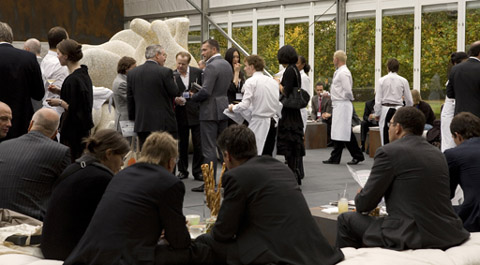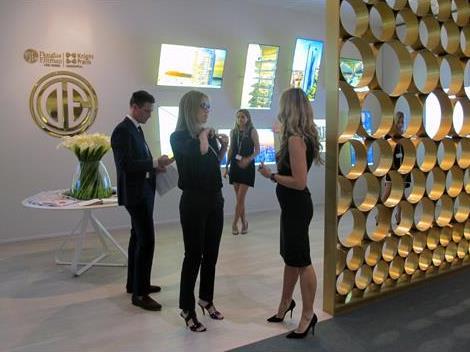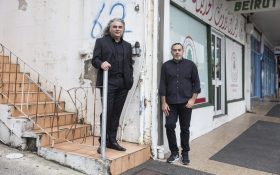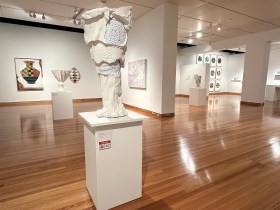The VIP Lounge presents a hot sponsorship opportunity for fair organisers; Art Basel Miami, Photo ArtsHub.
In today’s high flying global art world how early you can get into a fair can determine what you can buy, who you can meet and how well you are known.
All art fairs have VIP programs that dole out special access cards to a select group based on purchasing power and status – proven collectors, museum directors and chief curators among others.
However, fairs differ dramatically, and with the increased prestige of a fair so to that VIP circle becomes more competitive and elite. In this context, Vernissage and access to the VIP lounge are small feed. We are talking “First Choice”, a concept introduced by Art Basel – the giant of this game – that whispered “VVIP” access.
ArtsHub spoke to Director Asia Art Basel, Adeline Ooi, during her recent Australian visit. She clarified the distinction: ‘In HK we just have the Preview pass, unlike Basel and Miami where they have the two tier distinction – First Choice and the Preview.
‘It has just become very clear that art fairs nowadays are not what art fairs used to be. More and more the art fair is becoming a meeting place and I think it is wonderful that we have all the different captive audiences from different sectors of the art world. That is what the VIP pass is really for – to make sure collectors and these vested audiences have that chance, that time,’ said Ooi.
Most VIP passes permit early access to the fair as well as added entertaining and programming – including visiting local private collections and artist studios. Then there is the VIP lounge where you can “bump in to” key museum directors, curators or collectors in a more intimate zone over a glass of sponsored champagne. And as the status stakes rise, a VIP may be chauffeured from event to event in a sponsor’s limousine, have dinner by a top chef with a like-VIP crowd and the parties, the parties, the parties. Art Basel Miami has defined itself for its après-fair activities.
The VIP lounge has also become a marketing opportunity – you can buy your Havana cigars, an apartment or a watch while you take a break from your art shopping, as recently was the case at Art Basel Miami.

Deutscher Bank VIP Lounge, Frieze Art Fair 2008; Source Deutscher Bank
But there is a practical side to this shopping list of VIP extras. Ooi explained: ‘People see it as very hierarchical and elitist, but really it is just to give people that private view time… to give them that comfortable spot to case out a piece for museum acquisitions or walk with their patrons to show them their shopping list, or for collectors to just have opportunity to catch up with their galleries because there are things they are talking about.
‘Also people (gallerists) pay so much money to come to our fairs, and collectors have taken days off work, it is just about honouring that – everyone has invested something to be here, so lets given them what they need,’ added Ooi.
Like Ooi, Barry Keldoulis, CEO and Group Fairs Director of Art Fairs Australia, described the VIP experience as a complex, layered and vital one to the art fair ecosystem. ‘It gives established collectors the opportunity to view the fair more akin to a gallery environment.’
He added that it was: ‘a platform for targeted engagement – engagement with the art scene beyond the fair.’
Speaking about Australia’s next art fair, Sydney Contemporary (10-13 September 2015), Keldoulis said: ‘We will have an expanded program on what we had last time, engaging with the whole of Sydney art scene from private collection tours, to studio visits, dinners – the VIP visitor will be hand-held and guided through.’
Keldoulis added that VIP programming had become, ‘increasing important and (that) it is a real selling point to visitors.’
‘You wont be able to do business on a public day the way you can on a private day,’ said Ooi. ‘Hong Kong is still a very early fair. We want that captive audience to come back; we want that quality audience to stay,’ added Ooi. ‘It is important to include the institutions as much as collectors, curators, directors, art critics. They are very important to the ecosystems.’
Other dealers are of the opinion that the VIP system is somewhat redundant. ‘What does it mean VIP – isn’t everyone a VIP?’ said Geoff Newton of Melbourne gallery Neon Parc, who has annually participated in art fairs abroad since 2008.
‘People are shopping at a different pace these days – they’re either buying in five minutes or over five days,’ he added. The VIP pass does not change that psyche of art fairs.
Sydney dealer, Darren Knight, who will head to Art Basel Hong Kong for the first time next month said: ‘Obviously they are important because of the way art fairs are structured. They are there as an encouragement for collectors to come, and by way of sending VIP passes (to targeted collectors) may convert them to go.’
Knight added, ‘It just makes the viewing experience easier.’
Keldoulis said that one of the misconceptions was that it was during the Preview days when all the sales were made ‘Everyday is important. (Recognising that) gives dealers the opportunity to tailor to different stages of the fair – major collectors, then swap to something more appropriate for the weekend crowd. They are different crowds but they are both very healthy for sales.’
Whether you hit the list or not, what is assured is that it has been complied strategically. If you visit Art Stage Singapore’s website in search of VIP programming you are faced with the simple statement: ‘Art Stage Singapore VIP Programme is exclusive and by invite only.’
Art Basel have taken a similar line. They require you to answer the following – oh, and expect to have it verified:
- a list of artists strongly represented in your collection
- a list of galleries participating to Art Basel from which you regularly purchase
- a list of museum boards with which you are affiliated
In other words, while the celebrity and collecting glitterati might schmooze themselves in to the headlining parties and preview days, top drawer VIP access is still reserved the top drawer collectors. And would we want it any other way? It is a win-win-win-win for dealer-fair organisers-collectors – and yes, ultimately, the artist.





